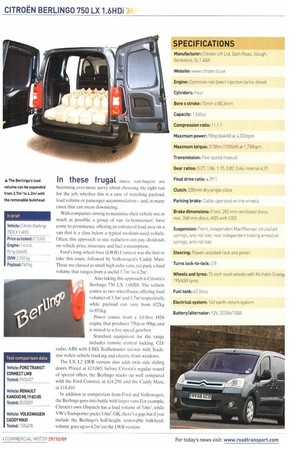I n these frugal times, van-buyers are becoming ever-more savvy about
Page 34

Page 35

Page 36

If you've noticed an error in this article please click here to report it so we can fix it.
choosing the right van for the job, whether this is a case of matching payload, load volume or passenger accommodation — and, in many cases, that can mean downsizing.
With companies aiming to maximise their vehicle use as much as possible, a group of van in-betweeners' have come to prominence offering an enhanced load area on a van that is a class below a typical medium-sized vehicle. Often. this approach to size reduction can pay dividends on vehicle price, insurance and fuel consumption.
Ford's long-wheel-base (LWB) Connect was the first to take this route, followed by Volkswagen's Caddy Maxi. These are classed as small high-cube vans, yet pack a load volume that ranges from a useful 3.7m' to 4.2m3.
Also taking this approach is Citroen's Berlingo 750 LX 1.6HD1. The vehicle comes in two wheelbases, offering load volumes of 33m' and 3.7m3 respectively, while payload can vary from 622kg to 851kg.
Power comes from a 1.6-litre HDi engine that produces 75hp or 90hp, and is mated to a five-speed gearbox.
Standard equipment for the range includes remote central locking. CD/ radio, ABS with EBD, Trafficmaster sat-nay with Trackstar stolen vehicle tracking and electric front windows.
The LX L2 LWB version also adds twin side sliding doors. Priced at £13,065. before Citroen's regular round of special offers, the Berlingo stacks up well compared with the Ford Connect. at £14,250, and the Caddy Maxi, at £14,410 In addition to competition from Ford and Volkswagen, the Berlingo goes into battle with larger vans For example, Citroen's own Dispatch has a load volume of 5.0m3. while VW's Transporter packs 5.8m3. OK. there's a gap, but if you include the Berlingo's half-height. removable bulkhead, volume goes up to 4.2e on the LWB version. Productivity Having an engine capacity of just 1.6 litres may he seen as a good thing in terms of consumption, but the Berlingo weighs in at 2,150kg GVW, so it certainly can't be described as a 'twinkle-toed' option.
That said, we recorded 43.2rnpg for a laden fuel run. which stacks up comparatively well with the (admittedly bigger-engined) VW Caddy Maxi's 41.9mpg and the Ford Connect LWB's 40.8mpg.
For an unladen run, the Citroen recorded 45.7mpg, which was second to the Caddy Maxi with 46.2mpg.
In the rear, our test Berlingo gets a payload of 749kg, while a PVC load area mat conies as standard on the 1.X L2 model, along with both near and offside sliding doors, which makes for excellent load access these combine well with the low load lip.
Also included are six load tie-down points and interior side-wall protection.
We do admire Citroen's decision to include the aforementioned features — not every manufacturer throws in these practical features as standard. And if you're operating in town, and under pressure, they all stack up to create a highly functional load carrier.
On the road While the liansit Connect and Caddy Maxi feel like precision tools. the Berlingo is more of a relaxed drive.
It delivers a ride that is just the right side of soft, impressively absorbing any bumps and ruts without complaint, and this helps to reduce fatigue, particularly on long-distance work.
Granted,it's not one to be hustled through the corners, but it remains composed enough when called on — it behaves safely even when fully loaded.
This is aided by the engine, which is a smooth operator, spinning with refinement right up to the red line and delivering enough torque to keep you moving at maximum GVVV.
That said, it's by no means rapid, and the larger horsepower output options available from its rivals give them a competitive edge if time is at a premium. In everyday usage, though. it works well enough.
We're less keen on the gear shift, however, which lacks definition from gate to gate, and feels loose in operation. And the same goes for the steering, which is vague in feel and suffers from overtly strong centring.
Safe rather than satisfying is the watchword here. You're never going to be engaged with the Berlingo, but neither are you going to be found wanting.
Cab comfort ics a mixed bag when it comes to the Citroen's interior. On one hand, there's a plethora of cubhies and storage, including the optional super-useful fold up/down Extenso dual passenger-seating arrangement, which enhances usable space, while the middle occasional seat
allows for a third occupant (something its rivals don't have).
Primary controls are clearly labelled, while switches and stalks are well positioned, although the central electric window switches do take a moment to find.
Cup and bottle holders abound, and an overhead parcel shelf, together with the generous door bins, offer some hefty storage options.
However, for all its tilting to the god of functionality, the Berlingo fails to impress in other areas.
The driving position, for instance, has you sat low and feels a little awkward, while the imposing dashboard and intruding central transmission further impact on the overall ambiance of the cabin.
That said, we have to admit the Citroen does feel well screwed together. and this is evident when you're on the move.There are no squeaks or rattles to report. and this helps to provide a well-insulated cabin, whether around town, or on the motorway, where exterior noise intrusion is impressively subdued. •








































































































































